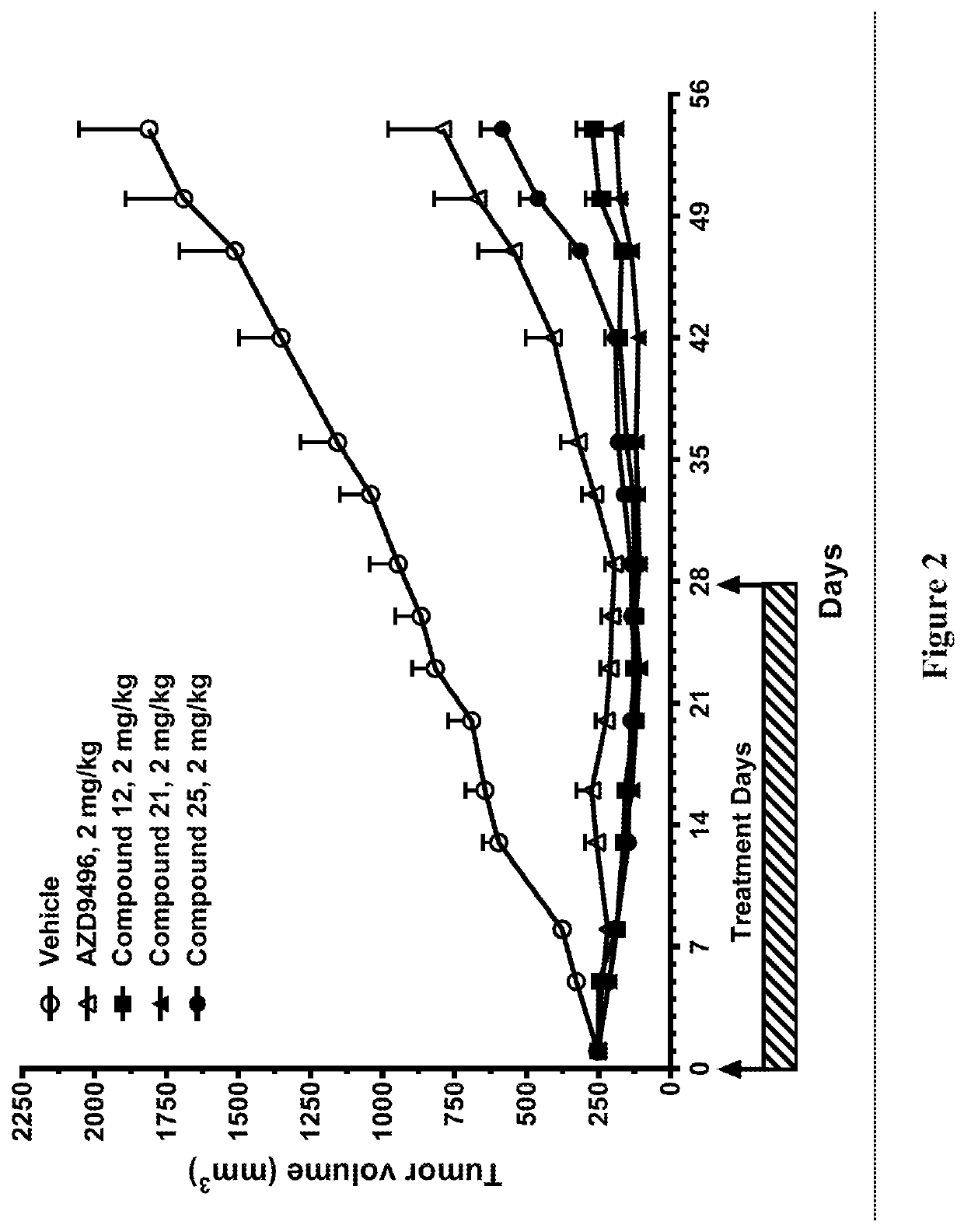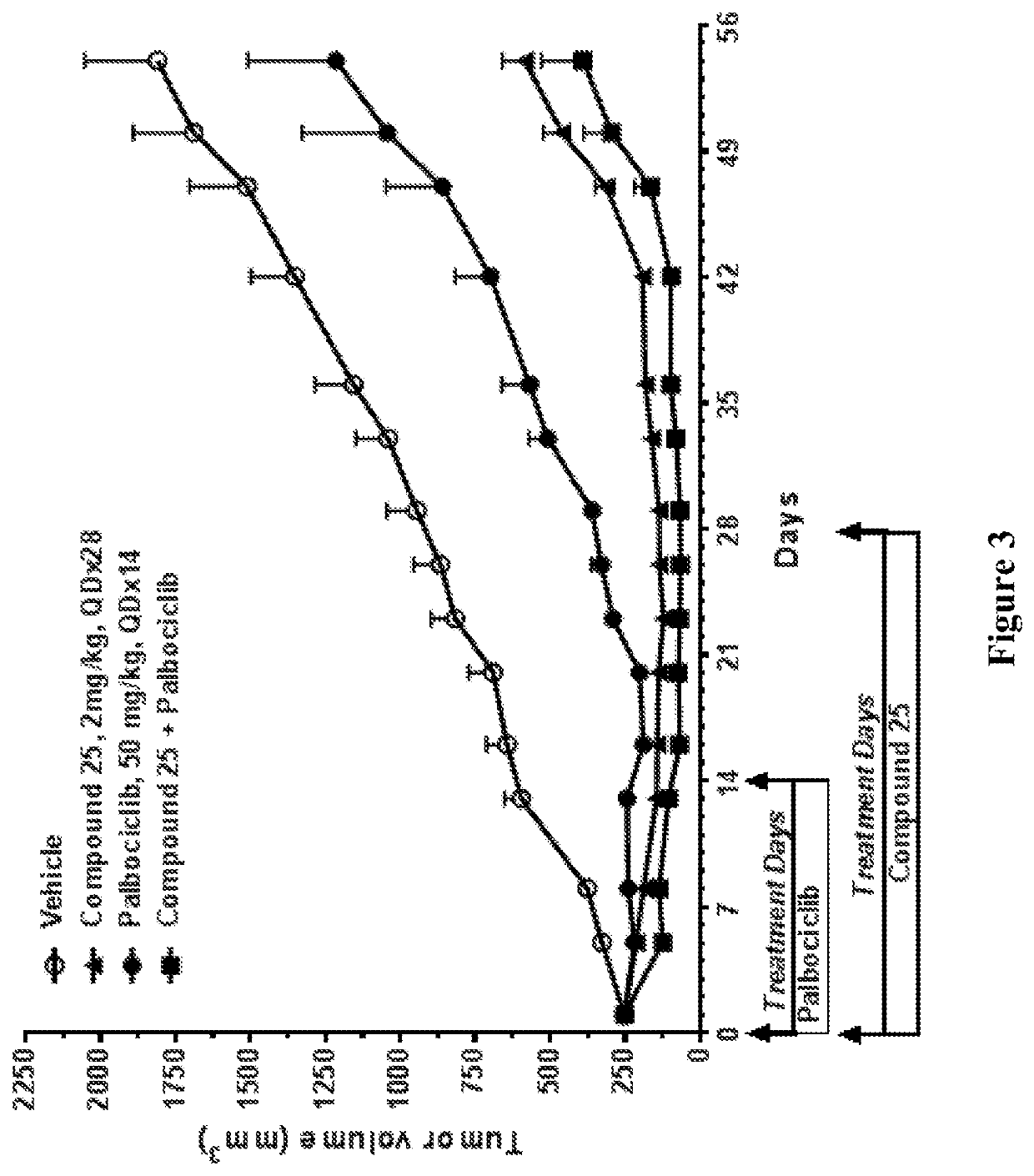Selective estrogen receptor degraders and uses thereof
a technology of estrogen receptor and selective degradation, applied in the field of selective estrogen receptor degraders, can solve the problems of limiting the effective degradation of er, so as to reduce or avoid symptoms, signs or causes of the condition, delay or minimize one or more symptoms associated, effect of improving overall therapy
- Summary
- Abstract
- Description
- Claims
- Application Information
AI Technical Summary
Benefits of technology
Problems solved by technology
Method used
Image
Examples
example 1
of Compound 1 and Derivatives Thereof
[0173]
Step 1. Synthesis of 1-2
[0174]A solution of (2R)-1-(1H-indol-3-yl)propan-2-amine (2 g, 11.48 mmol), acetic acid (1 mL) and 2,6-difluoro-4-iodobenzaldehyde (3 g, 11.19 mmol) in Toluene (20 mL) was stirred at 80° C. for 12 h. The resulting mixture was then cooled to room temperature and concentrated under vacuum. The residue was purified by a silica gel column with ethyl acetate / petroleum ether (1 / 100-1 / 10) as the eluent to afford the desired product (2 g, 42% yield).
Step 2. Synthesis of 1-3
[0175]To a solution of 1-2 (2 g, 4.71 mmol) in 1,4-dioxane (20 mL) were added N,N-diisopropylethylamine (920 mg, 7.08 mmol) and 2,2-difluoropropyl trifluoromethanesulfonate (1.61 g, 7.06 mmol). The resulting solution was stirred at 100° C. for 12 h. The reaction was cooled down to room temperature and then quenched with water (50 mL). The mixture was extracted with ethyl acetate (50 mL×3). The organic phase was washed with brine (50 mL) and concentrated un...
example 2
of Compounds 13B and Derivatives Thereof
[0180]
Step 1. Synthesis of 13-1
[0181]To a solution of 5-fluoro-1H-indole-3-carbaldehyde (2.0 g, 12.3 mmol, 1.00 equiv) in toluene (20 mL) were added ammonium acetate (1.14 g, 14.8 mmol, 1.20 equiv) and nitroethane (24 mL) at room temperature. The resulting solution was stirred at 130° C. for 5 h. The solid was filtered out and the filter cake was washed with ethyl acetate (10 mL×3). The filtrate was concentrated under vacuum, and the residue was diluted with water (40 mL) and extracted with ethyl acetate (35 mL×3). The combined organic layer was washed with brine (40 mL×3), dried over anhydrous sodium sulfate and concentrated under vacuum to afford 5-fluoro-3-[(1Z)-2-nitroprop-1-en-1-yl]-1H-indole (2.23 g, 83%) as a yellow solid.
Step 2. Synthesis of 13-2
[0182]To a solution of 5-fluoro-3-[(1Z)-2-nitroprop-1-en-1-yl]-1H-indole (2.0 g, 9.1 mmol, 1.00 equiv) in tetrahydrofuran (50 mL) was added lithium aluminum hydride (1.37 g, 36.0 mmol, 4.00 equ...
example 3
of Compound 16B
[0191]
Step 1. Synthesis of 16-1
[0192]To a solution of 3-bromo-1,1,1-trifluoropropan-2-one (10 g, 52.37 mmol) in trichloromethane (60 mL) at room temperature, was added a solution of NH2OH—HCl (5.46 g, 78.56 mmol) in water (10 mL) dropwise. The resulting solution was stirred at 65° C. for 24 h. After cooling to room temperature, the mixture was diluted with water (30 mL), and extracted with dichloromethane (40 mL×3). The organic phase was washed with brine (50 mL×2), dried over anhydrous sodium sulfate, and concentrated under vacuum. The residue was purified by distillation under reduced pressure (0.1 MP) and the fraction was collected at 70-80° C. to afford the desired product (4.6 g, 43% yield) as a colorless oil.
Step 2. Synthesis of 16-2
[0193]To a solution of (E)-N-(3-bromo-1,1,1-trifluoropropan-2-ylidene)hydroxylamine (4 g, 19.42 mmol) in methyl-tert-butyl ether (800 mL), were added 1H-indole (9.1 g, 77.68 mmol) and sodium carbonate (12.5 g, 116.83 mmol). The resul...
PUM
 Login to View More
Login to View More Abstract
Description
Claims
Application Information
 Login to View More
Login to View More - R&D
- Intellectual Property
- Life Sciences
- Materials
- Tech Scout
- Unparalleled Data Quality
- Higher Quality Content
- 60% Fewer Hallucinations
Browse by: Latest US Patents, China's latest patents, Technical Efficacy Thesaurus, Application Domain, Technology Topic, Popular Technical Reports.
© 2025 PatSnap. All rights reserved.Legal|Privacy policy|Modern Slavery Act Transparency Statement|Sitemap|About US| Contact US: help@patsnap.com



